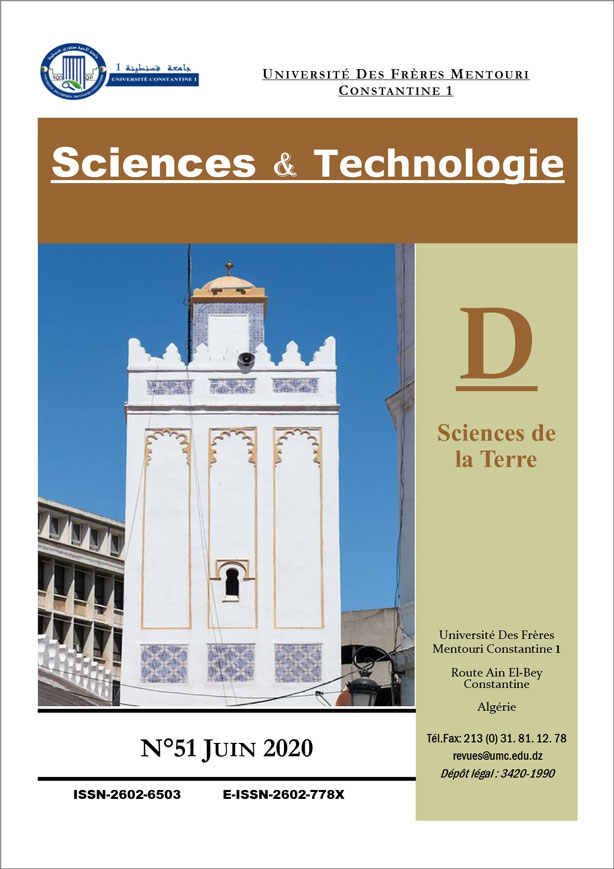FOR FLOOD-RESILIENT CITIES
Case of the city of M'sila, Algeria
Keywords:
Floods, management, risk, urban resilience, decision supportAbstract
The national territory subject to flooding is disastrously presenting a major constraint for the economic and social development of the country. According to the census carried out by the civil protection services, one commune out of three (485 communes) is likely to be flooded in part or in full. These floods are the most frequent and destructive natural disasters, causing significant human and material damage.
Prevention of these risks is of particular interest to the sustainable development of the country. In view of the increase in risk, only voluntary action seems appropriate, based on the recognition that taking into account flooding in land use planning and development can not be limited to an overly local, sectoral and short-term approach , But it presupposes a comprehensive policy for the prevention of natural hazards. A series of measures was therefore defined in July 2003, which led, inter alia, to the introduction of Law 04-20 of 25 December 2004 on disaster management in the context of sustainable development.
The main contribution of this study is to identify the avenues for reflection that allow us to build on a solid scientific foundation for the construction of a city resilient to the risks of floods. The objectives of this research are to provide information on the level of resilience of the city to flood scenarios and to help the public authorities to make appropriate decisions Time to increase the level of resilience of urban areas and to show that other avenues deserve to be explored in order to overcome the current impasse expressed by the rising cost of damage.
References
Barroca B., (2006). Risque et vulnérabilités territoriales : Les inondations en milieu urbain. Thèse de doctorat de l'Université de Marne la Vallée, Champs-sur-Marne, 296 p. + annexes.
Barroca B., Serre D. & Diab Y., (2012). Le concept de résilience à l’épreuve du génie urbain. VertigO - la revue électronique en sciences de l'environnement [Online], 12.
Boutté G., (2006), Risques et catastrophes : comment éviter et prévenir les crises ?, Papyrus, Montreuil.
Bernardara P., Schertzer D. & Lang M., (2005). Regional patterns of flood and rain extreme value index in the South of France. Geophysical research abstracts, 7.
Bourrelier P. H., Deneufbourg G. & de Vanssay B., (2000). Les catastrophes naturelles, le grand cafouillage. Santé et Société, Ed. Osman Eyrolles, 262 p.
B Barroca., G Hubert et Y Diab., (2006), Vulnérabilité : une clé de lecture du risque inondation, Journées Scientifiques de l'Environnement, Créteil , France.
Dauphiné A. & Provitolo D., (2003). Les catastrophes et la théorie des système auto organisés critiques. In V. Moriniaux (ed.), Les risques, éditions du Temps, p. 255.
Dauphiné A., (2001). Risques et catastrophes: Observer, spatialiser, comprendre, gérer. Armand Colin.
Djament-Tran G. & Reghezza M., (2012). La résilience urbaine. Les villes face aux catastrophes. Paris, Editions Le Manuscrit
Donze J., (2007). Le risque: de la recherche à la gestion territorialisée. Géocarrefour, n° 82, p. 3-5.
Jacques Veron , (2007), La moitié de la population mondiale vit en ville, in Population & Sociétés , Numéro 435, Juin 2007, bulletin mensuel d'information de l'institut national d'études démographiques.
Lallau B., (2011) La résilience, moyen et fin d’un développement durable. Éthique et économique, 8, 168-185.
Lamarre D., (2008), Climat et risques : Changements d'approches. Travaux du Groupement de recherches du CNRS sur les risques liés au climat Groupement de recherches sur les risques liés au climat (Dijon), Paris : Tec, 170 p.
Ledoux. B., (2006), La gestion du risque inondation, Tech et Doc Lavoisier, Paris.
UN HABITAT., (2007), GLOBAL REPORT ON HUMAN SETTLEMENTS, ENHANCING URBAN SAFETY AND SECURITY
Zevenbergen C et al., (2011), Urban Flood Management. London, UK: Taylor and Francis Group.
S Sebhi., (1987), Mutation du monde rural Algérien, le Hodna, O.P.U, Alger, PP.19-23.
Merabet A., (2006) : Etude de la protection de la ville de Sidi Bel Abbés contre les inondations, Mémoire de Magister, Université de Djilali Liabes-Sidi Bel Abbés.
C Bidou., (1982), Modes de vie et nouvelles couches moyennes : modèle culturel et recherche d’identité , in Colloque de Dourdan, Plan Construction, juin 1982.
Boumezbeur A., (2002).- Atlas des 26 zones humides Algérienne d’importance internationale. DGF (Direction Générale des Forêts), Alger, 89 p. www.dgf.gov.dz/zones_humides/ressources/
atlas4.pdf
Verniers G., (1995). Aménagement écologique des berges des cours d’eau -- techniques de stabilisation. Presses Universitaires de Namur, Belgique, 77 pages.

